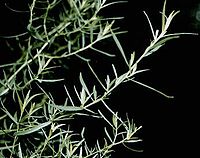
Photo from wikipedia
This study investigated the chemical composition, antioxidant and antimicrobial activity of essential oil extracted from Artemisia aragonensis Lam. (EOA). Hydrodistillation was employed to extract EOA. Gas chromatography with flame ionization… Click to show full abstract
This study investigated the chemical composition, antioxidant and antimicrobial activity of essential oil extracted from Artemisia aragonensis Lam. (EOA). Hydrodistillation was employed to extract EOA. Gas chromatography with flame ionization detection (GC-FID) and gas chromatography-mass spectrometry analyses (GC-MS) were used to determine the phytochemical composition of EOA. Antioxidant potential was examined in vitro by use of three tests: 2.2-diphenyl-1-picrilhidrazil (DPPH), ferric reducing activity power (FRAP) and total antioxidant capacity assay (TAC). Agar diffusion and microdilution bioassays were used to assess antimicrobial activity. GC/MS and GC-FID detected 34 constituents in the studied EOA. The major component was Camphor (24.97%) followed by Borneol (13.20%), 1,8 Cineol (10.88%), and Artemisia alcohol (10.20%). EOA exhibited significant antioxidant activity as measured by DPPH and FRAP assays, with IC50 and EC50 values of 0.034 ± 0.004 and 0.118 ± 0.008 mg/mL, respectively. EOA exhibited total antioxidant capacity of 7.299 ± 1.774 mg EAA/g. EOA exhibited potent antibacterial activity as judged by the low minimum inhibitory concentration (MIC) values against selected clinically-important pathogenic bacteria. MIC values of 6.568 ± 1.033, 5.971 ± 1.033, 7.164 ± 0.0 and 5.375 ± 0.0 μg/mL were observed against S. aureus, B. subtills, E. coli 97 and E. coli 57, respectively. EOA displayed significant antifungal activity against four strains of fungi: F. oxysporum, C. albicans, A. flavus and A. niger with values of 21.50 ± 0.43, 5.31 ± 0.10, 21.50 ± 0.46 and 5.30 ± 0.036 μg/mL, respectively. The results of the current study highlight the importance of EOA as an alternative source of natural antioxidant and antibacterial drugs to combat antibiotic-resistant microbes and free radicals implicated in the inflammatory responses accompanying microbial infection.
Journal Title: Molecules
Year Published: 2022
Link to full text (if available)
Share on Social Media: Sign Up to like & get
recommendations!